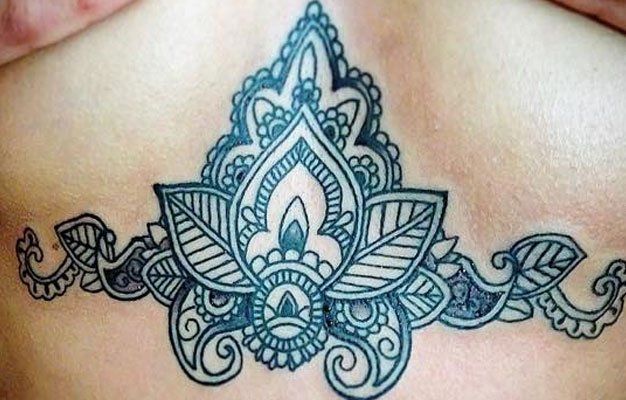TATTOO AFTER CARE INSTRUCTIONS
- After 1 hour remove bandage and lather area with soap, rinse thoroughly with warm water. Soak bandage if stuck. Do not re-bandage.
- Let air dry for 15-20 minutes or until completely dry.
- Use Tattoo Vitamin A&D ointment, or Aquaphor Healing ointment made by Eucerin. Apply a light coat on the tattoo 2-3 times a day, keeping the area moist for the first 2 weeks.
- Wash the tattoo twice daily with your hand. Let air dry and apply ointment.
- After 2 weeks switch to plain lotion, free of fragrance or additives ( Lubriderm recommended).
- Completely rub in a tiny amount of lotion 3-4 times daily for the next month.
- DO NOT soak or submerge in water. Short showers are okay. NO baths, swimming, hot tubs, soaking, and NO working out (cardio/weights etc.) for 3 weeks.
- DO NOT pick or scratch scabs. Let them fall off naturally.
- No direct sun for 2 weeks. Once healed, we recommend to always apply the highest SPF sunblock to tattoo when in the sun.
TOUCH-UP DISCLAIMER
If your tattoo is not taken care of, the life of your tattoo will be shortened. The care of your tattoo will affect whether or not you will need a touch-up. If touch-ups are needed, prices on touch-ups are based on the care of your tattoo and that will be determined by the artist once the tattoo is completely healed (about 1 month). To schedule a touch-up, you MUST come in the studio and have the artist give you an evaluation.

Piercing Aftercare Instructions
SALINE SOLUTION:
Saline is the key to quick healing - such as H2Ocean, it promotes balance so you heal faster! Do not use contact cleaning solutions.
Q-tips, especially when you have a piercing (such as nostril) where getting at one side may be difficult.
WARNING: CHEMICALS WILL NOT HELP YOU HEAL FASTER!!!
Chemicals of any kind will upset the balance inside your body and your piercing will heal very slowly.
DO NOT USE: ANY product containing an active ingredients and/or marked “For External Use Only” including, but not limited to: Satin®, Provon®, Rubbing Alcohol, Hydrogen Peroxide, Bactine®, Ear Care Solutions (benzalkonium/benzethonium chloride), Antibacterial soaps (i.e. liquid Dial® or Soft-soaps®), Neosporin® (or other petroleum based ointments), or Betadine®.

HOW TO CLEAN YOUR PIERCING-ALWAYS WASH YOUR HANDS BEFORE TOUCHING YOUR BODY PIERCING!!!
SALINE RINSE:
Soften any ‘crusties’ on the jewelry and the surrounding skin with saline and without turning the jewelry (soaking does a tremendous job- see below). Gently clear any lymphatic fluids (crusties) using a clean Q-tip and saline without turning the jewelry. Do this a few times a day, when activity might cause the ring to turn (exercise, etc.), and any time the jewelry feels ‘sticky’ or uncomfortable until your piercing is healed.
SALINE SOAK: Heat a small amount of saline in a clean container in the microwave 1/4 teaspoon per 8 ounces of distilled water preferably. Place this solution in a position that will soak the piercing. For instance, hold a small glass over your navel or nipple and lie back or use cotton balls, gauze, or a clean washcloth for hard to get piercings. Leave the warm saline solution there for 3-5 minutes, then rinse the piercing with fresh saline solution. Do this about 3 times per day. Also, do not excessively clean your piercing. NEVER move the jewelry back and forth through the piercing- it does more harm than good!!!
SALINE SOAK: Heat a small amount of saline in a clean container in the microwave 1/4 teaspoon per 8 ounces of distilled water preferably. Place this solution in a position that will soak the piercing. For instance, hold a small glass over your navel or nipple and lie back or use cotton balls, gauze, or a clean washcloth for hard to get piercings. Leave the warm saline solution there for 3-5 minutes, then rinse the piercing with fresh saline solution. Do this about 3 times per day. Also, do not excessively clean your piercing. NEVER move the jewelry back and forth through the piercing- it does more harm than good!!!
Tips & Advice
ALL PIERCINGS:
Do not play with new piercings, as physical irritation is the cause of many problems. Leave them alone. When clothing must cover the piercing, wear clean, loose, breathable (cotton) clothes.
NAVELS: Waistbands that contact the jewelry are the most common navel piercings problem. Your clothes must ride below your navel, or it may never heal. Maintain good posture, especially when sitting, to prevent pressure and irritation on navel piercings
NIPPLES: A bra will usually help reduce soreness in the days after a nipple piercing is performed. Larger breasted women are more likely to find this true. Try to wear breathable fabrics and consider wearing a cotton bra top to bed.
SWIMMING: Chlorine is tremendously drying and irritating to new piercings and should be avoided. If you cannot stay out of the water, then do your best to soak the piercing and rinse with saline whenever you swim. Avoid hot tubs until the piercing is healed. Lakes and oceans are a topic of debate, but a couple of things are for certain: sewage is frequently dumped in these water systems and presents an additional risk- lakes, slow-moving rivers, and marinas are the most risky areas, as the water is not frequently cleared out- staphylococcus is found in tropical waters. So please use discretion and pay attention to the condition of your piercing.
KELOIDS AND SCAR TISSUE: A large majority of people mistake irritation for scarring or infections. If you suspect that you are developing scar tissue- contact your piercer. There are several approaches to dealing with these problems and your piercer can help point you in the right direction.
NAVELS: Waistbands that contact the jewelry are the most common navel piercings problem. Your clothes must ride below your navel, or it may never heal. Maintain good posture, especially when sitting, to prevent pressure and irritation on navel piercings
NIPPLES: A bra will usually help reduce soreness in the days after a nipple piercing is performed. Larger breasted women are more likely to find this true. Try to wear breathable fabrics and consider wearing a cotton bra top to bed.
SWIMMING: Chlorine is tremendously drying and irritating to new piercings and should be avoided. If you cannot stay out of the water, then do your best to soak the piercing and rinse with saline whenever you swim. Avoid hot tubs until the piercing is healed. Lakes and oceans are a topic of debate, but a couple of things are for certain: sewage is frequently dumped in these water systems and presents an additional risk- lakes, slow-moving rivers, and marinas are the most risky areas, as the water is not frequently cleared out- staphylococcus is found in tropical waters. So please use discretion and pay attention to the condition of your piercing.
KELOIDS AND SCAR TISSUE: A large majority of people mistake irritation for scarring or infections. If you suspect that you are developing scar tissue- contact your piercer. There are several approaches to dealing with these problems and your piercer can help point you in the right direction.
Same-Day Appointments Available
215-633-8040
"I've gotten all five of my tattoos here and wouldn't go anywhere else. I've used two different artists and both did great work. Getting ready to make an appointment for my next one!"
- Kristen Phillips, Facebook review

